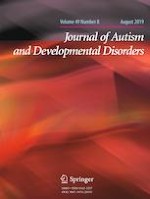22-05-2019 | Original Paper
Applicability and Effectiveness of Social Competence Group Intervention on Adults with Autism Spectrum Disorder in a Chinese Context: A Community-Based Study with Self- and Parent-Report
Gepubliceerd in: Journal of Autism and Developmental Disorders | Uitgave 8/2019
Log in om toegang te krijgenAbstract
Social competence training for adults with ASD were limited in comparison to intervention for children or adolescents. CBT-CSCA is a culturally-sensitive social competence training specially developed for adolescents in Hong Kong. With its demonstrated effectiveness, the current study outlined the adaptions of its adult version, CBT-CSCA (Adult) and examined its treatment effectiveness. Thirty-six adults (aged 18–29 years, with a FSIQ above 80) completed the intervention. Significant improvements were shown in overall social competence, from both self- and parent-report, and negative mood. Participants also reported satisfactory knowledge gain and confidence in applying content learnt after each session. The study provided evidence support to the applicability and effectiveness of social competence training for adults with ASD in the Chinese culture.
